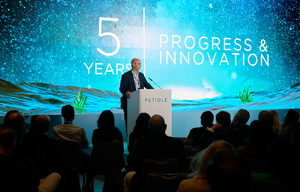Infrastructure investments have become a hot topic since Donald Trump was elected president of the U.S. In an interview with finews.ch, Mirjam Staub-Bisang explains how institutional investors can profit most from the trend. She is the co-author of a recently-released book on the topic.
Mirjam Staub-Bisang, you are the co-author of the second edition of «Infrastructure as an Asset Class». What has been added in this edition?
I was asked to describe and integrate aspect of sustainability, because they are crucially important given the longevity of infrastructure investments.
We have entirely new chapters on sustainable infrastructure, the energy sector and social infrastructure. The book discusses the energy sector because of its relevance for institutional investors.
Could you elaborate a little further?
It is about generating renewable energy, the transport of energy through grids or gas pipelines, the storage of energy and district heating or «district energy».
How do you define infrastructure project?
All public and private facilities necessary for the functioning and the development of an economy are part of the infrastructure.
«The financing of social infrastructure is gaining in importance»
Historically, investors cared most about the economic infrastructure – transport, communications transmission, energy and water supply as well as waste disposal. Today, the financing of social infrastructure, such as schools, hospitals, retirement homes or administrative buildings, is gaining in importance.
Investments in infrastructure have become a major issue with the election of Donald Trump as president of the U.S. How will infrastructure investments by the U.S. government affect the U.S. economy?
Donald Trump in his manifesto said he wanted to invest billions in infrastructure. The huge infrastructure program promised will give several industries a boost and lead to an economic recovery in the U.S.
This in turn will present investors with a chance to participate in listed infrastructure securities or U.S. companies in general. Apart from the large caps, this will benefit the shares of those companies most which focus on the domestic market.
In what way are investments in infrastructure political ones?
One of a government's main tasks is to provide a functioning infrastructure, to build and maintain it – financed with taxpayers' money.
Creating and maintaining the critical infrastructure for an economy costs an annual $2.5 to $3.5 trillion or 3.5 percent of global gross domestic product, according to OECD estimates.
«Unprecedented level of national debt among Western countries has led to a backlog on investments»
The unprecedented level of national debt among Western countries, fueled by a monetary policy which has been extremely expansive ever since the financial crisis, has led to a backlog on investments. This in turn has led to the decay of a lot of infrastructure.
And what are the consequences of this?
Private institutional investors in almost all industrialized countries have to step in to finance the improvement of infrastructure because of the increasing demands for cost cuts. By contributing to the financing, the influence of private investors also increases, which leads to big political discussions, in particular if the investors are foreign.
Globally speaking, where is spending on infrastructure a major issue in particular?
The need for infrastructure is enormous in emerging markets because of the population growth and urbanization. An estimated 75 million people move to cities in those countries – every year.
Today, 54 percent of the global population live in cities. By 2050, we estimate this figure to have risen to 66 percent. That means, some 6 billion people will live in cities in 2050, with 90 percent of the increase expected to come from African and Asian countries.
This will present governments with enormous challenges in respect to the provision of food, water and energy, waste disposal and mobility.
The fact that some 75 percent of the infrastructure that will exist in 2050 hasn't been built yet, presents an enormous opportunity to investors and our society – even taking sustainability into consideration.
What about infrastructure projects and investments in Switzerland?
Investors can participate in listed providers of power, water and heating. The big players are Axpo, Alpiq and BKW, but also some smaller public utility companies, which offer attractive dividend payments.
The shares of the large power station operators have come under pressure since the decision to exit nuclear and fossil-fuel energy, as the price for power consumed has falling in Europe.
How can pension funds and insurers best participate in the infrastructure trend given the current low interest environment?
Institutional investors can also participate directly via private direct investments. Be it as single investors or together with others – as happened for instance in the case of Swissgrid, the national high-voltage grid.
 Mirjam Staub-Bisang is the co-founder and CEO of Independent Capital Group, an asset manager for institutional and private clients, with a focus on sustainable securities and real estate. The lawyer is a board member of Bellevue Group, of INSEAD in Fontainebleau/Singapore and a member of the council of Profond Sammelstiftung. Staub-Bisang studied at the University of Zurich and acquired an MBA at INSEAD in Fontainebleau. She's the author of books on sustainable investment and infrastructure. Her latest book is «Infrastructure as an Asset Class», published by Wiley & Sons. It will also be published in Chinese shortly. Staub-Bisang was named a «Young Global Leader» by the World Economic Forum (WEF) in 2009.
Mirjam Staub-Bisang is the co-founder and CEO of Independent Capital Group, an asset manager for institutional and private clients, with a focus on sustainable securities and real estate. The lawyer is a board member of Bellevue Group, of INSEAD in Fontainebleau/Singapore and a member of the council of Profond Sammelstiftung. Staub-Bisang studied at the University of Zurich and acquired an MBA at INSEAD in Fontainebleau. She's the author of books on sustainable investment and infrastructure. Her latest book is «Infrastructure as an Asset Class», published by Wiley & Sons. It will also be published in Chinese shortly. Staub-Bisang was named a «Young Global Leader» by the World Economic Forum (WEF) in 2009.




































